6 Virtual Memory
Memory Basic
Memory Multiplexing
MMU(Memory Management Unit) converts virtual to physical

Different Processes/Threads share the same hardware
- Need to multiplex CPU (Scheduling)
- Need to multiplex use of Memory (Virtual Memory)
Important Aspects of Memory Multiplexing
- Multiplexing: Allow multiple processes to simultaneously occupy memory
- Protection: Prevent access to private memory of other processes
- Translation: Give each program the illusion that it has its own private address space, and then translate accesses from virtual to physical
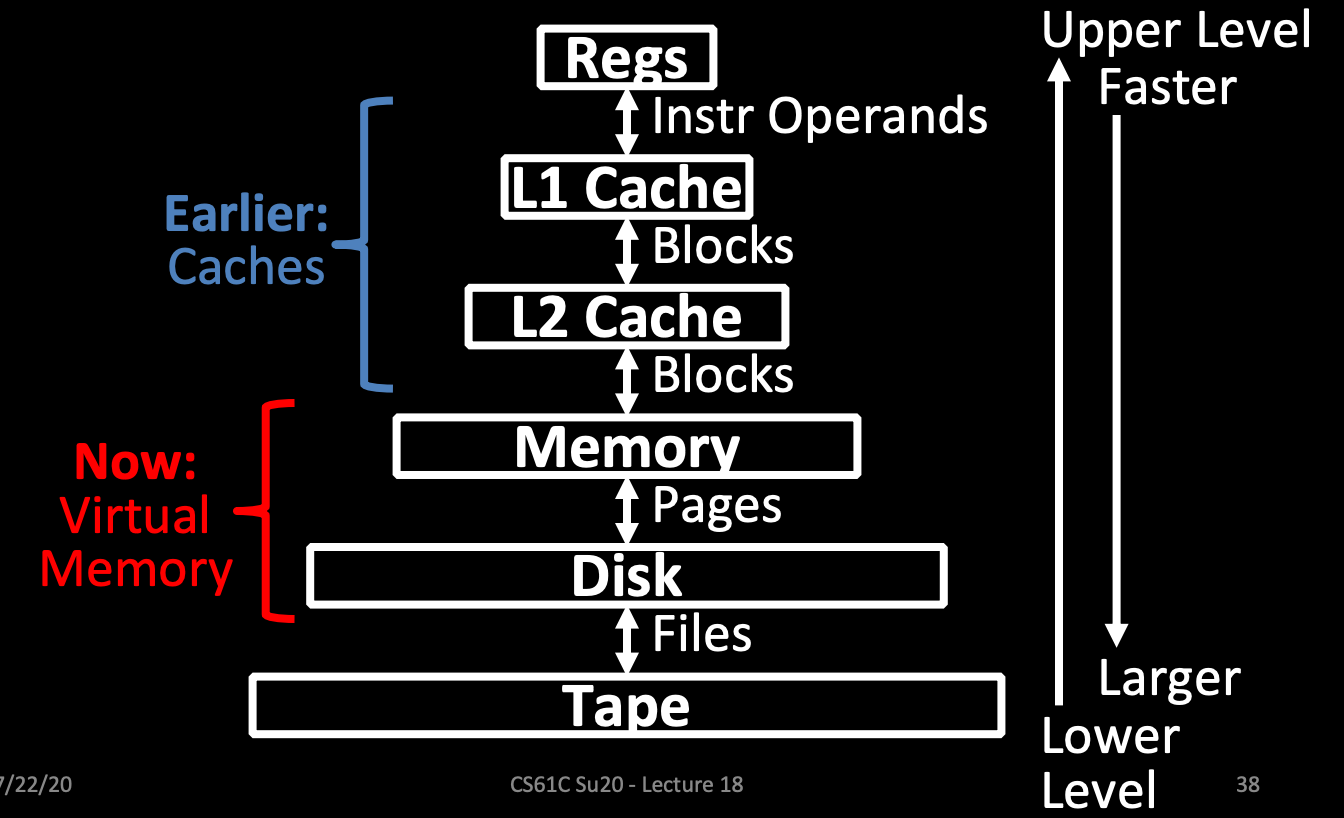
Base & Bound Machine
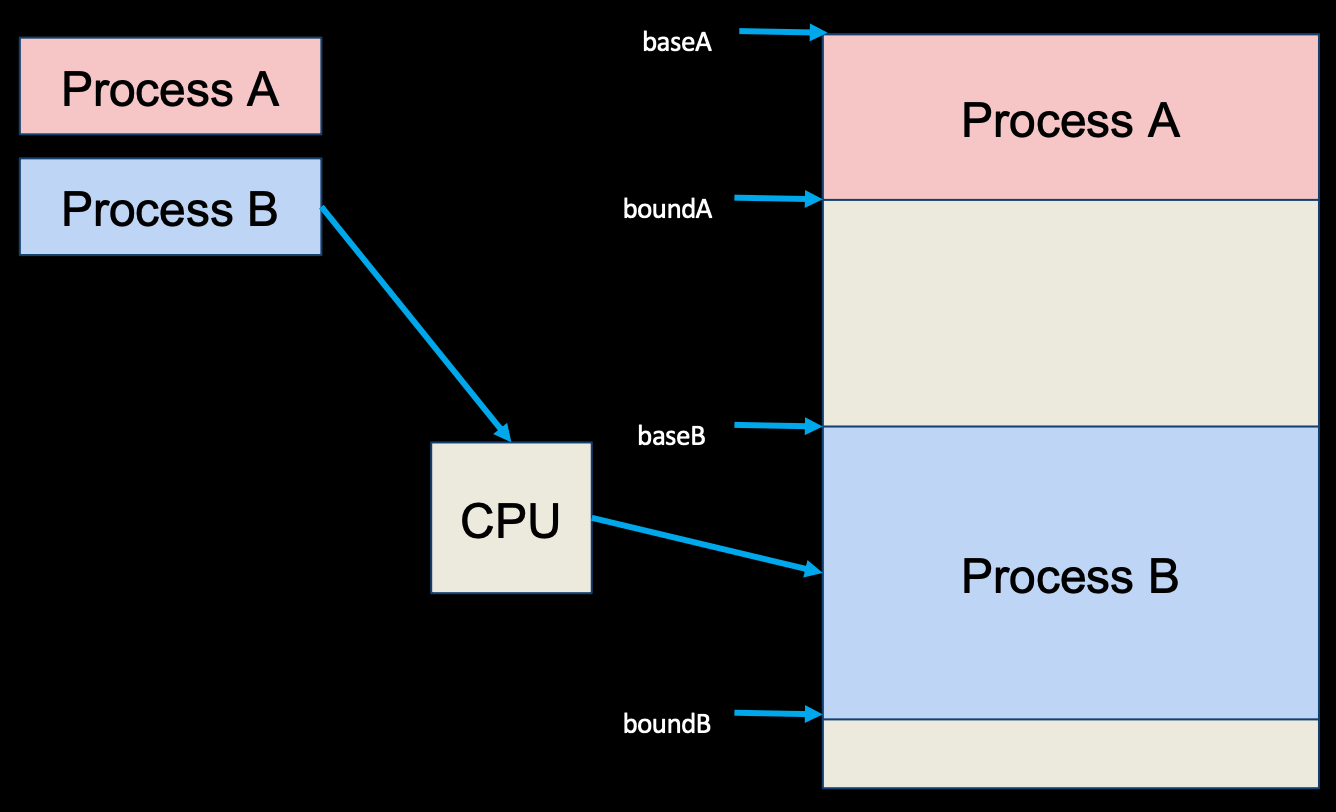
Problems
May need more space than segment allows
External Fragmentation: Free chunks between allocated regions

Internal Fragmentation: Space inside allocated address space may not be fully used
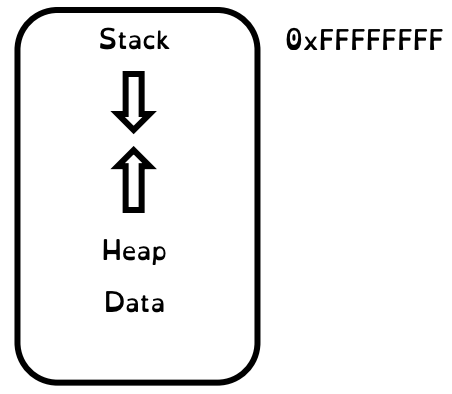
Simple Segmentation
if I have 16 bit address with 4 segments (code, data, stack, heap), use 2 segment bits
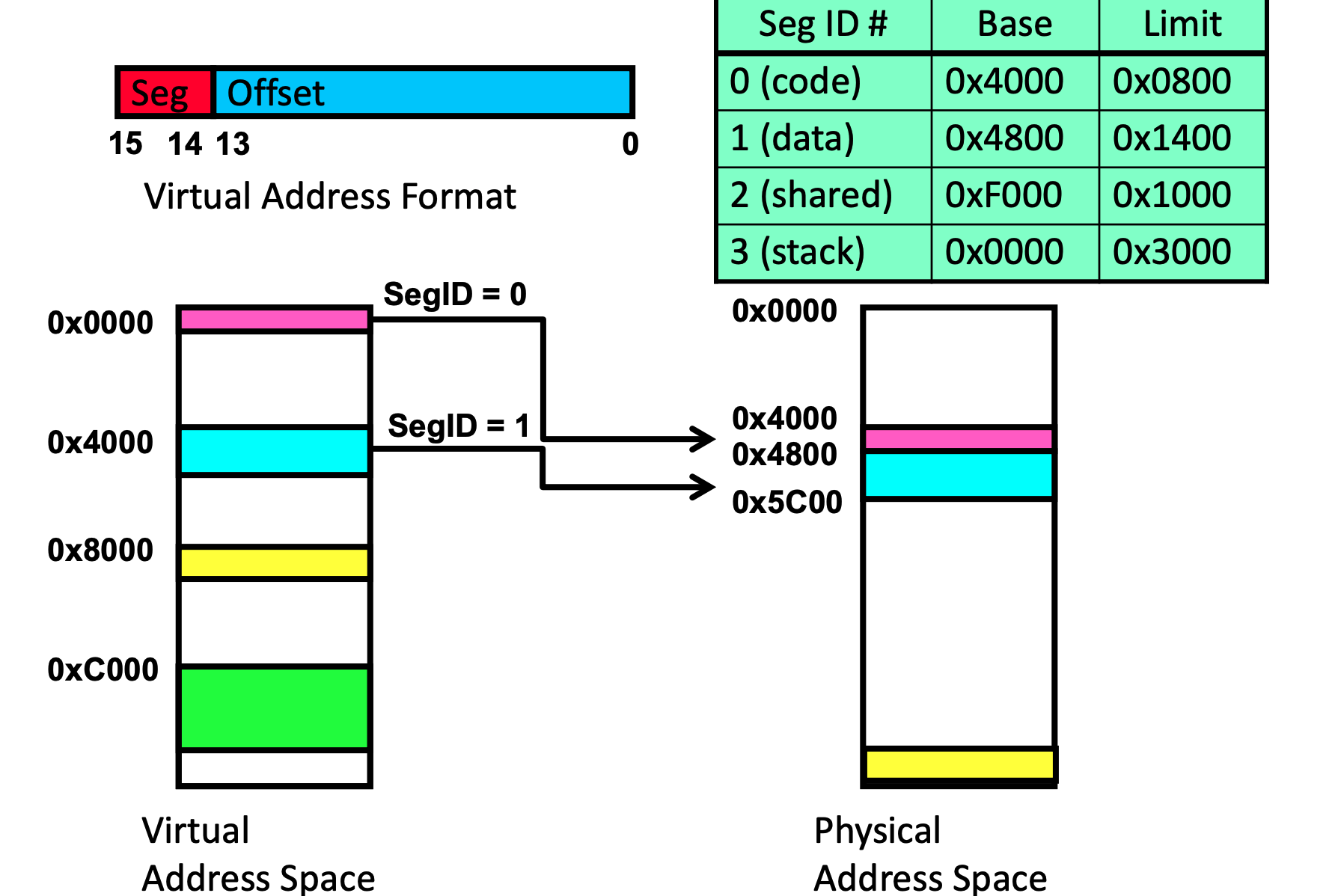
Pros: Minimize internal fragmentation
Cons: Still External fragmentation
Address Translation
Simple Paging
Instead of having segments of various sizes, divide physical memory and virtual memory into equal units called pages
- Pages are the same size in both virtual and physical memory, and RAM is an integer multiple of pages
- Avoids internal fragmentation: Each program has access to one or more pages(do not have to be contiguous)
Virtual/Physical addresses can be broken into page number + offset(much likeT/I/O)
- Memory Size = Bytes
- Page size Bytes = Bytes
- VPN/PPN = log_2(# of pages) = log_2(Memory Size/page size)
Virtual addresses: Divided into pages indexed by virtual page number(VPN)

Physical addresses: Divided into pages indexed by phisical page number(PPN) or frame number

Example
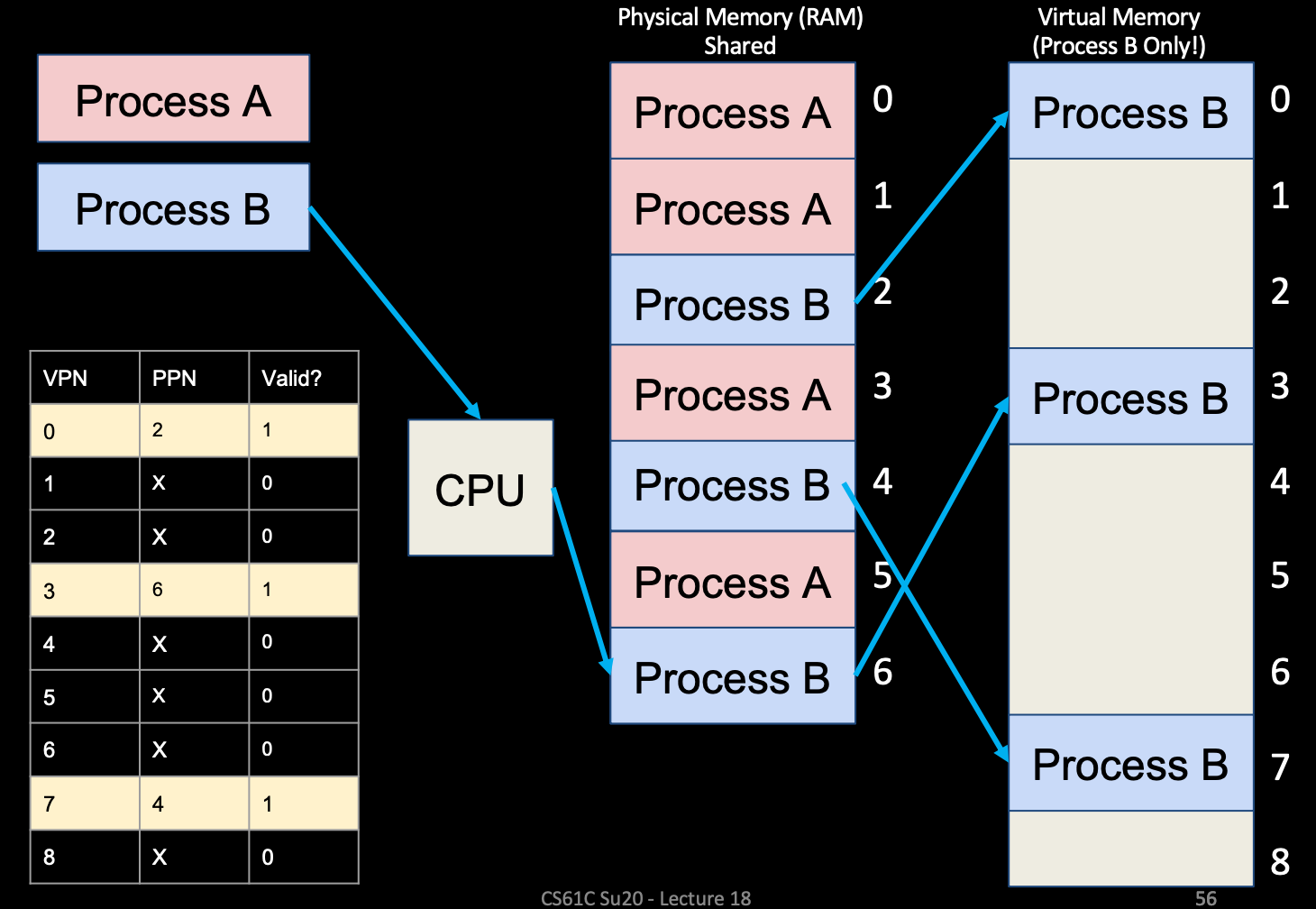
Page Table Entry
Each program has a page table, whose address store in PTBR(Page Table Base Register)
PTBR value saved/restored in PCB on context switch
- Dirty bit: Page has been modified recently
- Valid bit
- 1: virtual page is in physical memory
- 0: OS needs to fetch page from disk(Page Fault)
- Permission bits: Access Rights checked on every access to see if allowed (else protection fault)
- Read, Write, Executable
- PPN
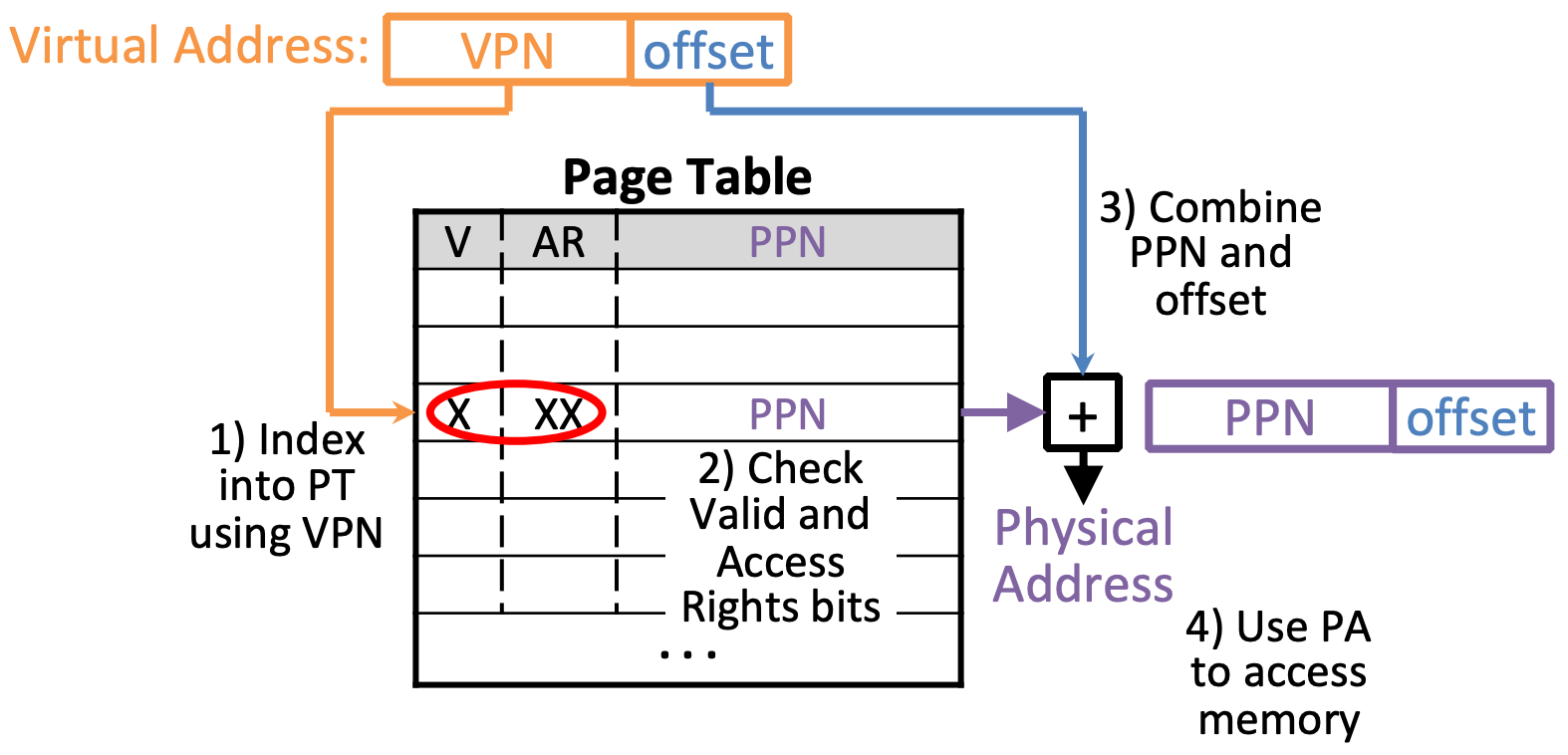
Example:
If we ignore the valid and permission bits, assume that page table entry only contains PPN
Number of pages needed by Page table =
Problems
32 bit processor, 12 bit offset-> 4KB page size
Memory = * 4 bytes(20 + valid bit + permission bits) = 4 MB
64 bit processor, 12 bit offset
Memory = * 8 bytes(52 + ...) = ridiculous!
Problems:
- can be really large (span multiple pages), and sparsely populated
- have to load the entire page table(may only need sections)
Multi-Level Paging
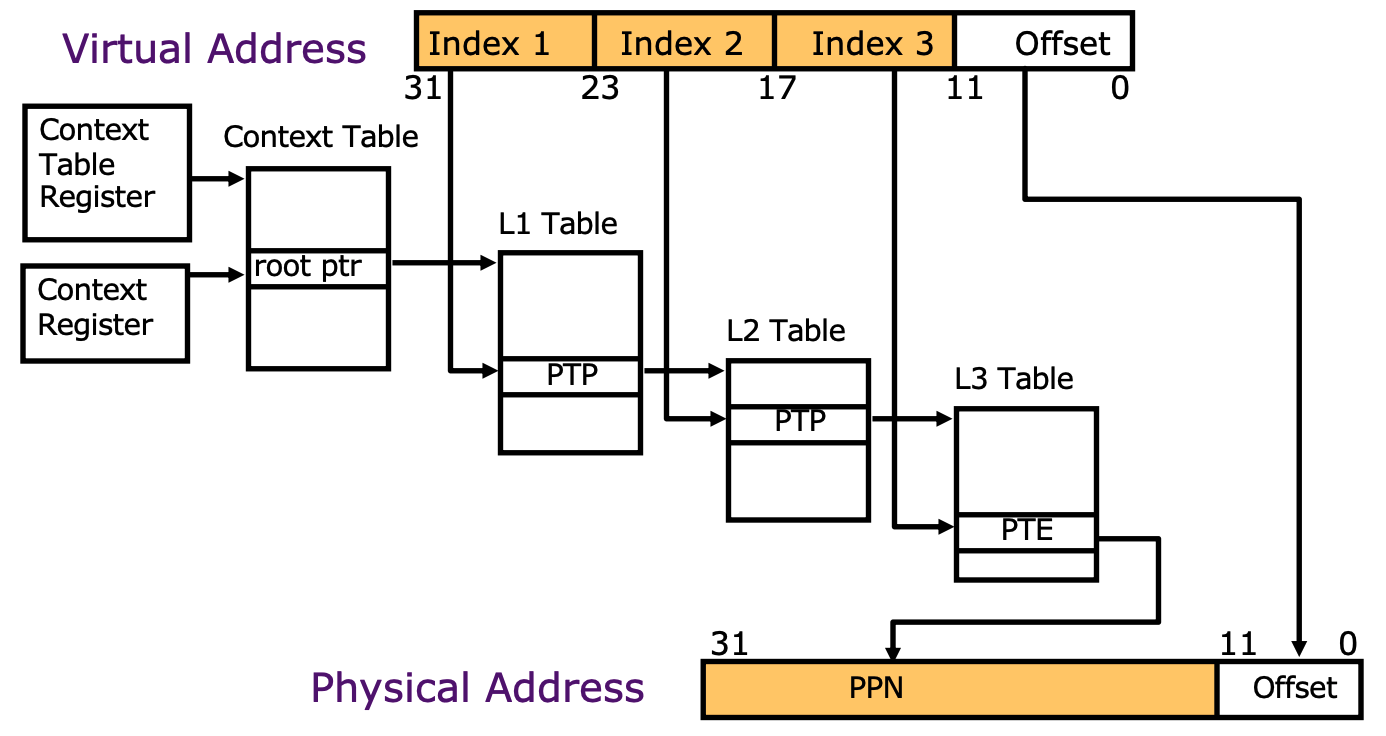
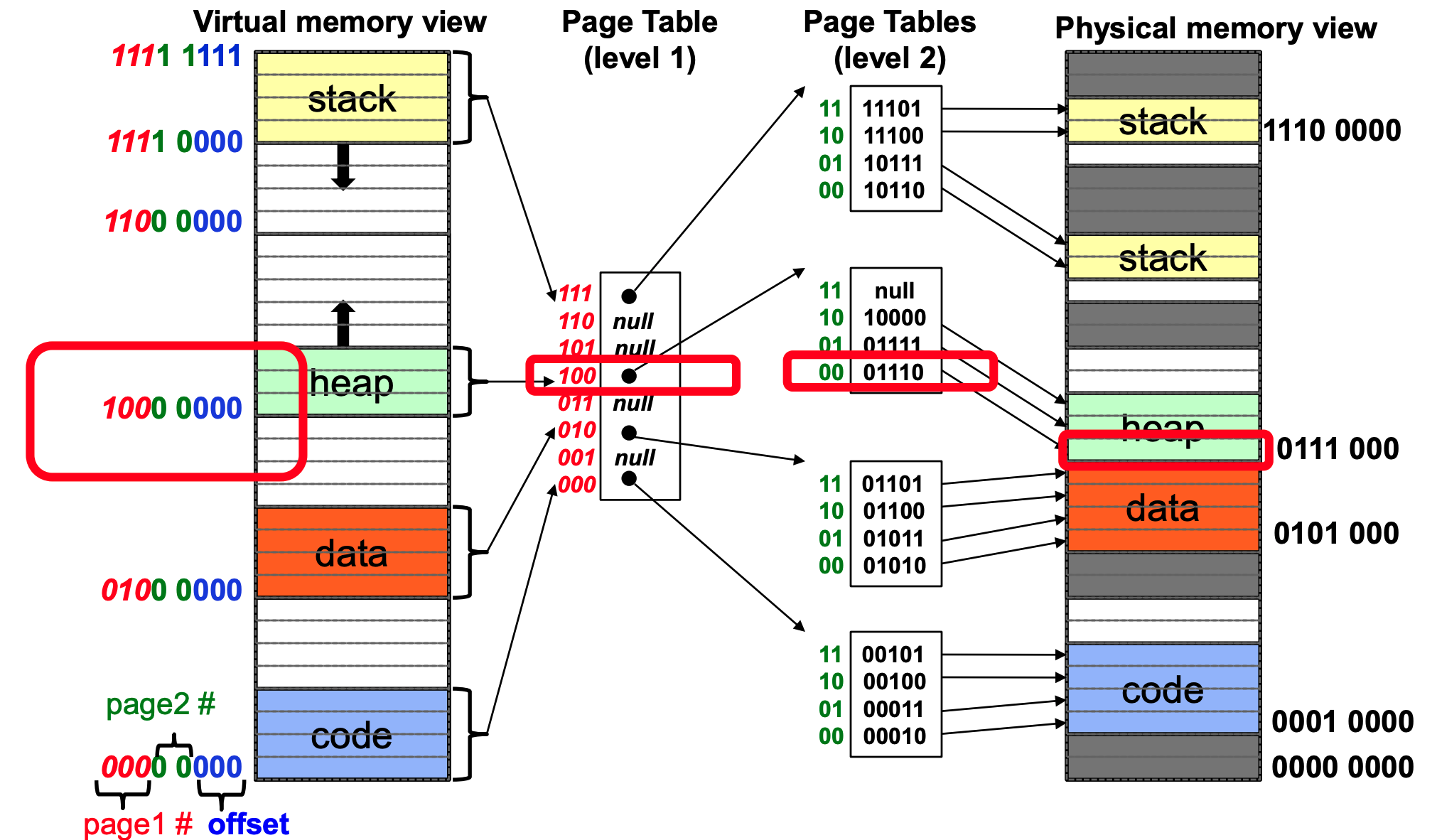
Inverted Page Table
Physical memory < Virtual memory: Much of process space may be out on disk or not in use

use a hash table
- Size Directly related to amount of physical memory
- Very attractive option for 64-bit address spaces: PowerPC, UltraSPARC, IA64
Cons
- Complexity of managing hash chains: Often in hardware!
- Poor cache locality of page table
Address Translation Comparison
| Advantages | Disadvantages | |
|---|---|---|
| Simple Segmentation | Fast context switching (segment map maintained by CPU) | External fragmentation |
| Simple Paging | 1.No external fragmentation 2.Fast and easy allocation | 1.Large table size(~ virtual memory) 2.Internal fragmentation |
| Multi-Level Paging | 1.Table size ~ # of pages in virtual memory 2.Fast and easy allocation | Multiple memory references per page access |
| Inverted Page Table | Table size ~ # of pages in physical memory | 1.Hash function more complex 2.No cache locality of page table |
Translation Lookaside Buffer (TLB)
MMU Problem: 2+ physical memory accesses per data access = SLOW
Build a separate cache for the Page Table: TLB
TLB vs Cache
- TLBs usually small, typically 32–128 entries
- TLB access time comparable to cache (much faster than accessing main memory)
- TLBs usually are fully/highly associativity
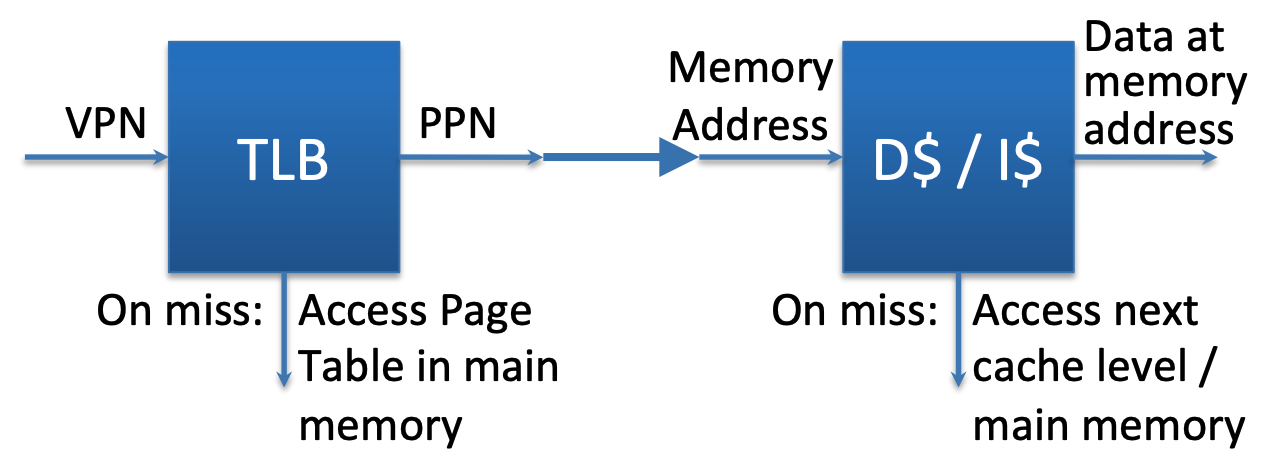
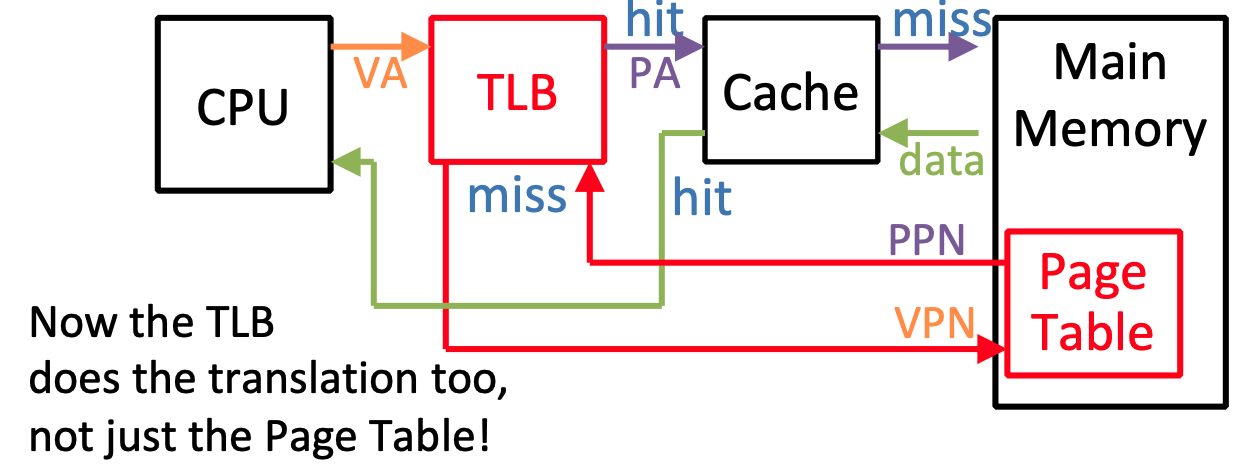
Page Locality
- Instruction accesses spend a lot of time on the same page (since accesses sequential)
- Stack accesses have definite locality of reference
TLB Entry Format
- Valid: whether that TLB ENTRY is valid (unrelated to PT)
- Ref: Used to implement LRU, set when page is accessed, cleared periodically by OS
- Access Rights: Data from the PT
- Dirty: Consistent with PT
- PPN: Data from PT
- VPN: Data from PT
Page Replacement Policy
Basic Policy
- Random: Pick random page for every replacement
- FIFO: Replace page we miss least recently
- MIN: Replace page that will be used farthest in future
- LRU: Replace page we used(hit & miss) least recently(approximation to MIN)
How to implement LRU?
Maintain a linked list. On each use, remove page from list and place at head, LRU page is at tail
Problems: Many instructions for each hardware access
Clock Algorithm
To approximate LRU, arrange all pages in circular list. Maintain a hardware use bit per physical page

On reference: set use bit
On page fault:
- Advance clock hand
- Check use bit: 1 means used recently, clear and leave alone; The first 0 is selected candidate for replacement
Problem: Replace an old page, not the oldest page
Nth Chance Clock Algorithm
OS keeps counter per page: # sweeps
On page fault, OS checks use bit:
- 1: clear use and also clear counter (used in last sweep)
- 0: increment counter. if count=N,replace page
Large N: good approximation
Small N: more efficient
Paging Questions
Page Sharing
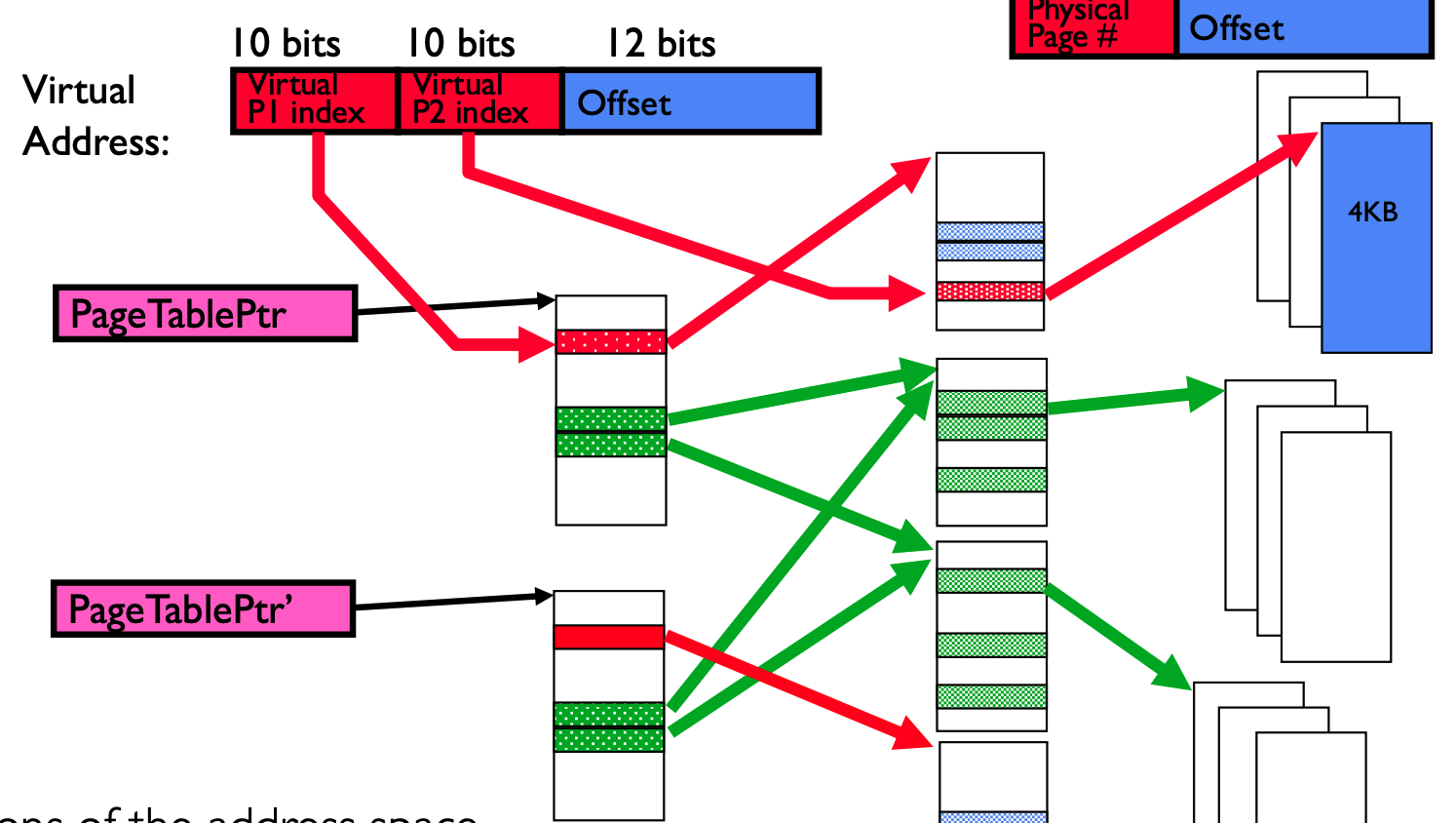
Senario
- Different processes running same binary
- User-level system libraries (execute only)
- Shared-memory segments between different processes
Contex Switch
Address Space just changed, so TLB entries no longer valid
Options
- Invalidate TLB: simple but might be expensive
- Include ProcessID in TLB: needs hardware
Demand Paging
(Success, TlbEntry) = TLB_Lookup(VPN)
if (Success == True) # TLB Hit
if (CanAccess(TlbEntry.ProtectBits) == True)
Register = AccessMemory(PhysAddr)
else
RaiseException(PROTECTION_FAULT) # Protection Fault
else #TLB Miss
PTEAddr = PTBR + (VPN * sizeof(PTE))
PTE = AccessMemory(PTEAddr)
if (PTE.Valid == False) # Invalid PTE
RaiseException(SEGMENTATION_FAULT)
else
if (CanAccess(PTE.ProtectBits) == False)
RaiseException(PROTECTION_FAULT)
else if (PTE.Present == True) # Retry
TLB_Insert(VPN, PTE.PFN, PTE.ProtectBits)
RetryInstruction()
else if (PTE.Present == False) # Page Fault
RaiseException(PAGE_FAULT)
Protection Fault
Page table entry has protection bits inconsistent with operation
- Read/write/execute operation not permitted on the page
Normally, OS sends segmentation fault, kills thread
Page Fault
Suppose user references page with invalid PTE
Load the page off the disk into a free page of memory. Switch to some other process while we wait
If memory full, replace page (LRU). If old page modified, write back to disk. Change its PTE and any cached TLB to be invalid
Maps page table entry in page table to frame, makes it present
Interrupt thrown(switch to thread from original faulting location) when page loaded and the process’ page table is updated.
Continuous swapping between disk and memory called "thrashing"
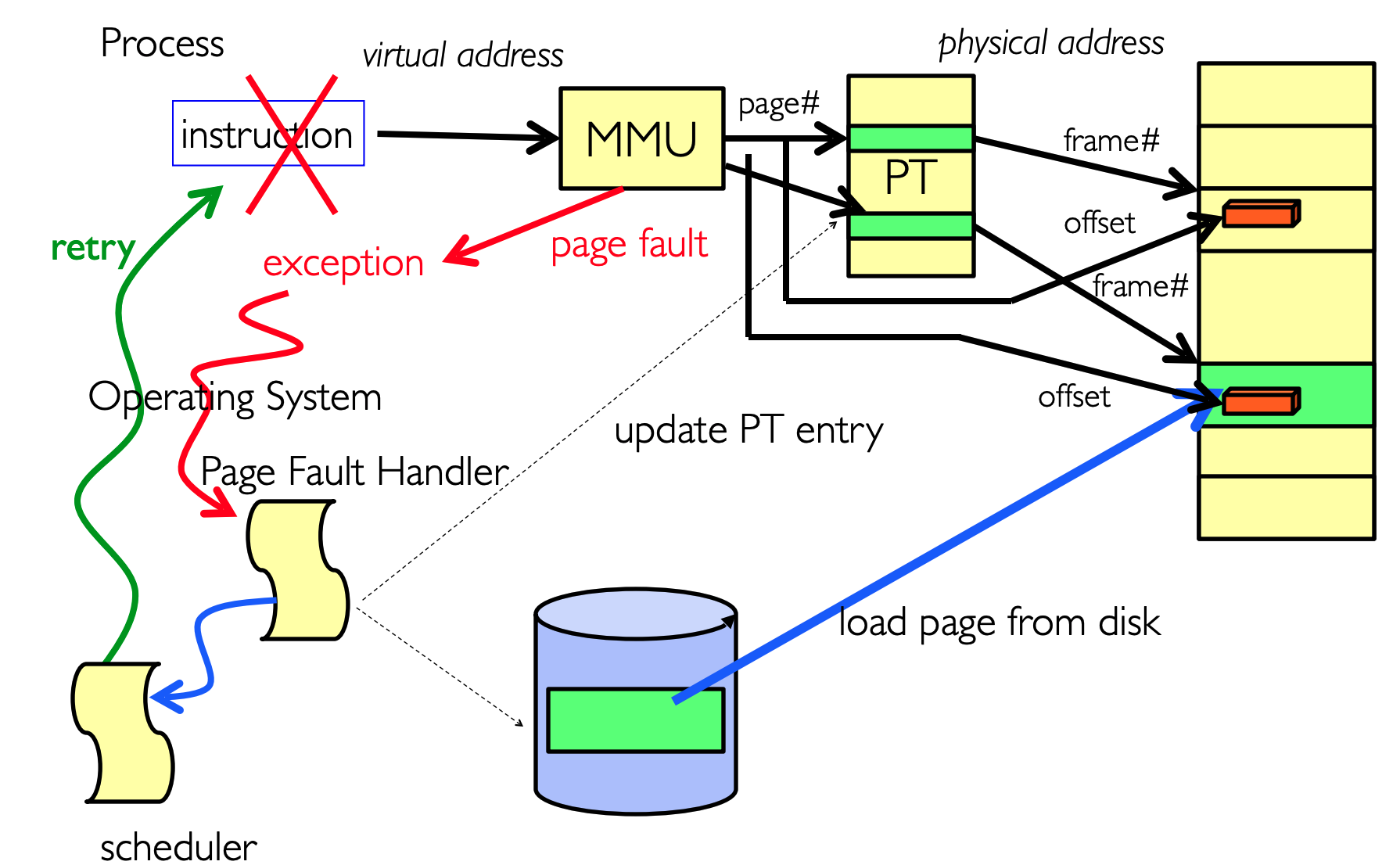
Other Scenarios
Process Fork
- Create a copy of the page table
- Entries refer to parent pages – NO-WRITE
- Shared read-only pages remain shared
- Copy page on write (different stack, heap)
Exec
- Only bring in parts of the binary in active use
- Do this on demand